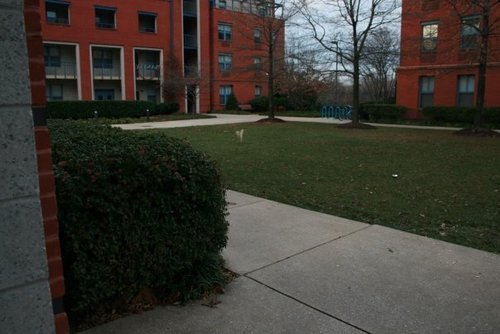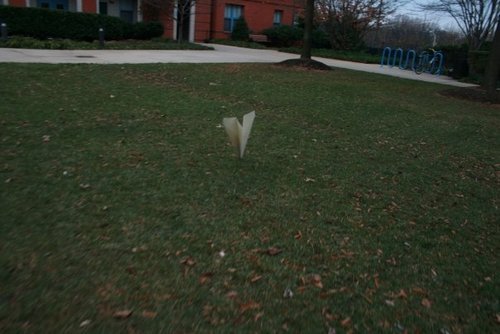


For a long time, I very rarely used color in my work. Color frightened me. A month or so ago, I bought a box of Crayola crayons in a set of 64 different colors and this drawing is a result of an accumulation of crayon drawings I did since then. I've been almost primarily using crayons in my sketchbook now, ranging from aggressive scraping to small rapid crayon touching in drawing and even to taking notes and doodling cartoons. This is visually a shock for me, as I previously used only graphite pencils or pens for sketching and note taking. It feels a dissolution of how I previously approached drawing because of the completely different texture and colors crayons have-- they are heavier on the page and can be layered and blended with each other physically. Crayons are not only of childhood but are childlike: messy and sticky. I wonder what hits more true- childhood as simple and idyllic or childhood as messy and wild ? But NEITHER EITHER/OR NOR ALL. Even how I approach my sketchbook has changed with or by my set of Crayolas; I've been using loose signatures to draw in, which can be layered and ordered how I wish at any time. This particular drawing is second to last of a series of drawings from the poem "you didn't know why i was laughing" by ellen kennedy.
i carried my red basket and bought the blueberries
the blueberries are stacked neatly in my red basket
we washed the blueberries and put them in two bowls
two pints of blueberries
we hid under a big blanket from everybody we are hidden
we squished our blueberries and ate them with spinach leaves like spoons
'i want to rub my face in my blueberries'
'so do it'
'okay'
i rubbed my face in my blueberries
i batted my eyelashes against your cheek and left blue streaks on your cheek
i thought about all the times i've almost been hit by a car for listening to loud music while walking and laughed.
Recently, I've been reading through Victorian era books on the "language of flowers", also known as "floriography". In late 19th century, these manuals on metaphoric flowers were ubiquitous in advice and etiquette books, indexing flowers popular to be given in bouquets from wooer to wooed and from wooed to wooer and detailing their supposed meaning. The idea of flowers and other plants having meaning and emotional significance goes far beyond the Victorian Era to the European Medieval ages in which flowers were most often symbolized as morals to the 15th century in Japan in which flowers took on meaning in the art of ikebana.
Kate Greenaway's Language of Flowers (1885)
What's curious to me is the boundaries of which these meanings were taken as fact. Such didactic almanacs from the 19th century were certainly not taken so strictly-- if so, pity on the poor hopeful who includes a pretty sprig from a white cherry blossom tree blissfully ignorant of it meaning 'deception'. But, these were clearly taken seriously in that these books were popularly owned and consulted. There is a struggle between believing in order to make concrete meaning from emotion and suspending this belief to indulge hope or prolong doubt that is acknowledged in the existence of these informational texts.
How much of my perception of the past is taken as fact? I don't know if that awareness directly shapes my present, but there is definite nostalgia involved in my work, and more recently directly conveyed by turning to crayons as a medium. The past is a significant element of the present, just as the future is, in confluence with the now. It can't be denied that the past is a worker in the present, so I struggle with the confluency of the two but undeniable separation of them as well. In both floriography and working with crayon, there is nostalgia for the past and a searching for the present meaning from the past.

This method of conversation with flowers is fascinating. One bud is a symbol, but symbolism opens interpretation for multiplicity. A defined meaning is not a solution-- it is a package of allusions and hints and that covers and hides itself while it exposes itself too. I see a correlation between the layering and accumulation in the way I've been approaching crayon in my drawings and the similar extents of layering and accumulating in "floriography". When conflicting flowers are presented in a bouquet, they are oft to lose their presumed meaning and simply become a beautiful bunch of flowers-- or they can be related to another in a projected histogram or brainstorm chart from 2nd grade or scatterplot or in endless tangents of meaning to make a cohesive nove, or, or, or so on. The contradictions of the banal in the excitement of living or the exciting in the banal that is felt so strong in childhood with a limited perception of time mirror the shifting of no-meaning and multitudes of meaning in flowers.






 /
/